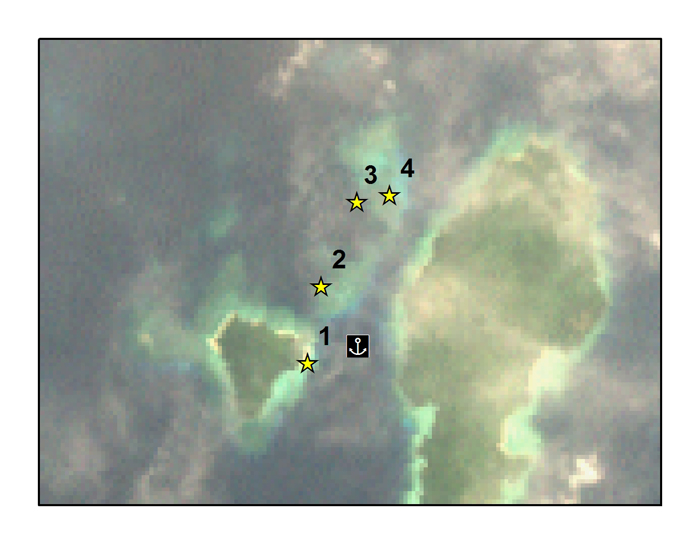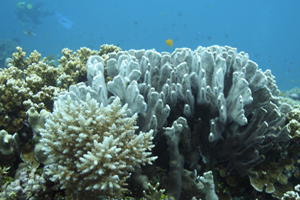
| Dikar / Telibang (6th December 2006) | N | E | satellite image |
| SV Infinity's anchorage | 02° 59.4000' | 106° 07.8000' | |
| Way points taken during snorkel and beach expedition: | 02° 59.8194' | 106° 07.8768' | 1 |
| 03° 0.1434' | 106° 08.0124' | 2 | |
| 03° 0.1692' | 106° 08.1384' | 3 | |
| 02° 59.5254' | 106° 07.8234' | 4 |

Expeditions
From SV Infinity's anchorage in the channel between Dikar and Telibang,
we made one snorkeling expedition and two dives.
Island observations
The beach on the east side of Dikar is approachable. There is a settlement
on the east side of Telibang, about halfway down the length of the island. We
did not meet anybody here but there were a few small fishing boats in the vicinity.
We explored over the course of two dives and one snorkel the reef extending
on the northwest side of the channel running between Dikar and Telibang.
Reef observations
Reef type: Fringing reef extending into a tongue.
There is a rock above the high water mark on the inner edge of the tongue.
Coral observations: The shallow areas (depth 2 to 4 meters) are aesthetically striking, for example a bright blue branching Acropora spp. colony, two meters in diameter, surrounded on all sides by colonies of Porites rus. The reef crest has100% hard coral coverage along much of its length. Coral genera observed at this site include: large massive Porites spp. boulders, Porites rus, table Acropora spp., branching Acropora spp., foliaceous Montipora spp., branching Hydnophora spp., Pachyseris speciosa, Goniopora spp., Echinophyllia spp., Stylophora spp., Pocillopora spp., Herpolitha spp., Fungia spp., Lobophyllia spp., Pectinia spp., Caulastrea spp., Echinopora spp., Leptoria spp., Psammacora spp., Platygyra spp., Pavona spp., Euphyllia spp., Seriatopora spp. and Galaxea spp. The scleractinian corals are generally in excellent condition. We observed seawhips at about 10 meters depth growing between large fields of foliaceous Montipora spp. just after we rounded the reef tip. The reef crest of the outer edge has dense coverage of Porites rus colonies. Close to the rock, on the backreef of the tongue, there is a shallow slope, from 1 to 5 meters, on which there are lagoon-type scenes of coral bommies on a mostly sand substrate. Many of the corals break the surface at low tide, including several large massive Porites spp. boulders. The sand continues down into the channel.
Fish observations: There is an abundance of small reef fish in the shallows. One delightful sight was a firetail dottyback (Labracinus cyclophthalmus) in a digitate section of a Montipora spp. colony. As we moved around the tip and to the outer edge of the tongue, we came across a denser population of fish including an enormous great barracuda just below the surface who kept returning to hang over us, fusiliers, one bumphead parrotfish and about ten groupers. Michel observed a shark and an unidentified sea turtle at about 20 meters depth. On the backreef, juvenile white damselfish (Dischistodus perspicillatus)lie in the sand just below the edge of the shallow reef while the adults dwell around the hard corals a few meters further up the slope.
Reef health and vitality observations: We sighted
just two corals with white band disease and saw no signs of crown of thorns
damage. There was an old 5 meter length of fishing net snagged on corals at
about 10 meters depth. We passed over one rubble area,
about 5 meters wide, which is possibly traces of a previous bomb blast. However,
new colonies of Montipora spp. and Acropora spp. are growing
in it. Some of the smaller Porites colonies in the shallows were suffering
from edge damage, a condition in which filamentous algae traps sediment on a
coral’s surface, encroaching gradually over live tissue.
scenes in the shallows at Dikar
massive Porites spp. boulders in the shallows

fishing net snagged on the reef; blue coral (Heliopora coerulea)
page1 page 2 page 3 page 4 page 5 page 6 page 7 conclusion